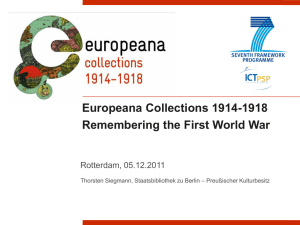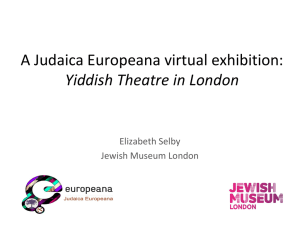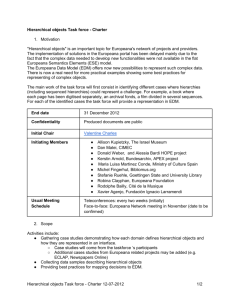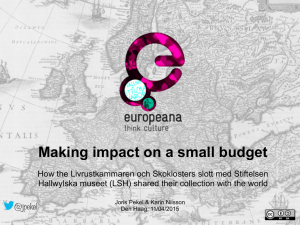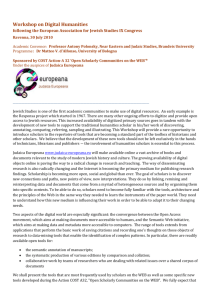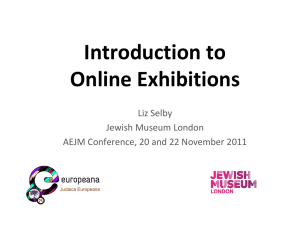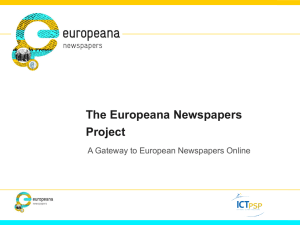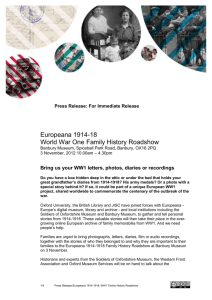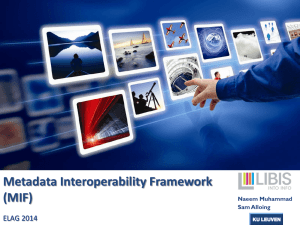1.22 Exploring Europeana
advertisement
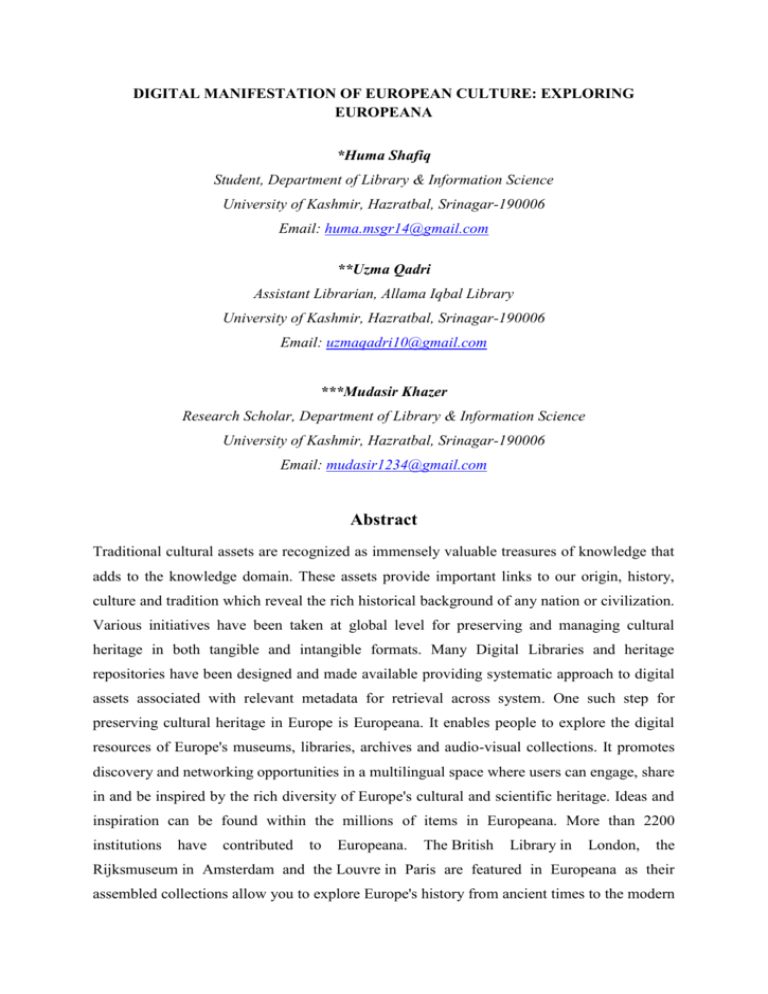
DIGITAL MANIFESTATION OF EUROPEAN CULTURE: EXPLORING EUROPEANA *Huma Shafiq Student, Department of Library & Information Science University of Kashmir, Hazratbal, Srinagar-190006 Email: huma.msgr14@gmail.com **Uzma Qadri Assistant Librarian, Allama Iqbal Library University of Kashmir, Hazratbal, Srinagar-190006 Email: uzmaqadri10@gmail.com ***Mudasir Khazer Research Scholar, Department of Library & Information Science University of Kashmir, Hazratbal, Srinagar-190006 Email: mudasir1234@gmail.com Abstract Traditional cultural assets are recognized as immensely valuable treasures of knowledge that adds to the knowledge domain. These assets provide important links to our origin, history, culture and tradition which reveal the rich historical background of any nation or civilization. Various initiatives have been taken at global level for preserving and managing cultural heritage in both tangible and intangible formats. Many Digital Libraries and heritage repositories have been designed and made available providing systematic approach to digital assets associated with relevant metadata for retrieval across system. One such step for preserving cultural heritage in Europe is Europeana. It enables people to explore the digital resources of Europe's museums, libraries, archives and audio-visual collections. It promotes discovery and networking opportunities in a multilingual space where users can engage, share in and be inspired by the rich diversity of Europe's cultural and scientific heritage. Ideas and inspiration can be found within the millions of items in Europeana. More than 2200 institutions have contributed to Europeana. The British Library in London, the Rijksmuseum in Amsterdam and the Louvre in Paris are featured in Europeana as their assembled collections allow you to explore Europe's history from ancient times to the modern day. The present paper makes an attempt to explore the wealth of cultural resources available through Europeana by analyzing its features through online survey. 1.1 INTRODUCTION The bequest of physical artifacts and impalpable ascribes of a group or society is what we simply call as Cultural Heritage. These artifacts and ascribes are inherited from past generations and maintained in present so that our future generations will be prosperous owing to its strong bonds to posterity. Heritage is considered to be a sustainable resource, which should not only be perceived as a national inheritance, but also as an integral part of the universal human endowment (Aita, n.d.). Integral part of universal human endowment definitely predicts the importance of sustaining our cultural heritage. Thus, before our heritage becomes endangered, steps need to be put in place to preserve both tangible and intangible cultural assets. Various initiatives have already been taken at the global level towards this endeavour and Europeana is one among them. European Parliament (2007) defines Europeana as a digital library that is a single, direct and multilingual access point to the European cultural heritage (as cited by Escande, 2009). Europeana provides access to thousands of digitized items throughout Europe including museum objects, paintings, archives, books, films etc. It is a non-profit initiative owned by European Foundation. The catalyst for Europeana was a letter sent by Jacques Chirac, President of France, together with the premiers of Germany, Spain, Italy, Poland and Hungary to President of the European Commission José Manuel Durão Barroso in April 2005. The letter recommended the creation of a virtual European library, to make Europe's cultural heritage accessible for all. The project was initialised with the recommendations present in the letter and thus, resulted in the launch of the prototype on 20 November, 2008. In the beginning, it gave access to 4.5 million digital objects (Europeana, 2013). At present, it is providing access to almost 29 million objects and is growing as the time passes. 1.2 ANALYZING EUROPEANA Europe has a diverse culture depicting varied forms of music, painting, literature, sculpture, film, architecture, etc. This vast and rich diversity of Europe’s cultural heritage is being preserved by the European Foundation in the form of a web portal, Europeana, giving the digital reflections of European culture enabling people to explore various archives, museums, libraries and audio-visual collections digitally. It promotes discovery and networking opportunities in a multilingual space where users can engage, share in and be inspired by the rich diversity of Europe's cultural and scientific heritage. It provides access to the millions of items inspiring and promoting ideas among the art lovers including hundreds and thousands of images (drawings, maps, paintings, pictures and photos of museum objects), videos ( TV broadcasts, films and newsreels), sounds (music and spoken words from tapes, radio broadcasts and discs) and texts (letters, newspapers, books, archival papers and diaries). It also includes some world famous topics and objects like the drawings of “Leonardo da Vinci”, Isaac Newton’s book about the “Laws of Motion”, Johannes Vermeer’s painting of the “Girl With A Pearl Earring” or objects about the “Berlin Wall”. More than 2200 institutions from 36 countries provide data to Europeana among which some top data providing countries are Germany followed by France, Netherlands, Sweden and Spain. Fig. 1 shows a list of the top 15 countries providing data to Europeana: Source: http://www.pro.europeana.eu/web/guest/content Fig. 1 1.21 Searching Europeana Europeana can b searched in four ways, general search, specific search, phrase search and refined search. 1.211 General Search It is the simple search interface provided by the Europeana to its users. Users need to know the Who, What, Where or When of the object they need to find and thus, type these words into the search box. Source: http://www.europeana.eu/portal/search.html?query=Isaac+Newton Fig. 2 The user gets large number of results while searching through this search type as highlighted in the above Fig. 2. If the user needs the particular information, he needs to switch to another type of searching, specific search. 1.212 Specific Search An advanced search interface used to narrow down the search results by using the same Who, What, Where and When key questions. In this case, a user can narrow his/her search with the arrow to the right of ‘Search All fields’ and selecting a category: ‘Titles, Creators, Subjects, Dates/Periods, Places’. Then enter the search term and hit ‘Search’. Alternatively, a user can enter the key question (who/what/where/when) followed by a colon (:) followed by the name/words from title/place/period or date, respectively. Source: http://www.europeana.eu/portal/search.html?query=who%3A+Isaac+Newton Fig. 3 Here, the number of results reduces from 1223 to 706 as seen in the Fig. 3. These search interfaces also have support for different spellings and multi-lingual queries. 1.213 Phrase Search Phrase searching is possible in Europeana. It can be done in two ways, either by putting quotation marks around the phrase (e.g. "art nouveau") or by using Boolean operator “AND” in between the keywords (e.g. art AND nouveau). For excluding any word, Boolean operator “NOT” is used (e.g. Auguste NOT Renoir). 1.214 Refined Search After initial search has been done results can be narrowed down with the ‘Refine your results’ functions. He/she can add another term by which the results can be further narrowed down. The user can also filter the search results by various ways like media type, language, date, country, provider and rights. Source: http://www.europeana.eu/portal/search.html?query=Auguste Fig. 4 The highlighted portion shown in the Fig. 4 helps the users refine their search results according to their requirements reducing the number of results to a large extent. 1.22 Exploring Europeana Apart from the above mentioned standard ways of searching, Europeana offers its users some alternate ways to explore and navigate through its collection. The users can come across the rich and diverse heritage of Europe in many ways. Its virtual exhibitions help the users to discover and learn more about specific themes. With extensive curatorial information that guides through the themes, the virtual exhibitions are displayed on the image carousel of Europeana's landing page, and can be also found in the 'Explore' tab at the top of the page. It can also be explored through the latest content contributed to the portal from their partner museums, archives, audio-visual archives and libraries. There are over 2200 institutions that provide data to Europeana. Its collection can also be accessed via those data providers. Another way of exploring it is through time. It provides an interactive timeline which lets the user to see items categorized by date. Map provides one more means to explore Europeana where the users can view their results on a map. Here, only geo-location possibilities can be explored thus, displaying the results for some of the search terms only. 1.23 Other Features in Europeana Europeana also provides many other features such as connecting to the original source of the material searched ensuring its authenticity. It provides some search features like stemming as in case of Google while typing the search term and also suggests an alternative spelling for spelling errors. Rights and licence information is available below each item’s thumbnail image. This multi-lingual portal provides information in 31 different languages allowing the users to translate item detail in their known language. Users can share various items on various social networking sites like Facebook, Twitter, Google+ and many more. They can also register to the portal through “My Europeana” section which provides them a personal space in Europeana. Here, a user can create alerts in order to be updated on any particular topic of their interest. They can also add their favourite items under certain tags which they can access anytime in their accounts. For later viewing, various items can be saved to the account. (Europeana.eu, 2013) 1.3 CONCLUSION Europeana is one of the leading cultural heritage portals from Europe opening a doorway to an ocean of digital collection from the museums, archives, libraries and audio-visual collection of Europe. It is presently providing access to approximately 29 million items having great cultural value and these figures are increasing day-by-day. Europe has taken a great step towards saving and sustaining their cultural heritage for the future. Taking the lesson from Europeans, every nation must work towards maintaining and preserving their culture for the coming future. Culture as a heritage is a very broad term which not only includes the material aspects like monuments, objects, buildings etc but also covers the living heritage incarnated in values, beliefs, social practices etc. No nation is having any scarcity of such cultural heritage but most of our ethnic values are prone to the threat of becoming extinct. Once these extinguish, these won’t be available for our future generations. Before such a time comes, each nation (even if at the individual levels of a person in order to give it a beginning) must take the responsibility of preserving the culture. This European cultural heritage can be treated as a boost for every heritage lover to generate ideas and provide the inspiration for new ethnic manifestations. REFERENCES Aita, H. E. M. A. (n.d.). Cultural heritage. Focus, 1. Retrieved from http://www.undp.ps/en/newsroom/publications/pdf/focus/04v1.pdf Escande, A. (2009). Europeana Today and Tomorrow. BAAC Conference-Vilnius. Retrieved from http://pro.europeana.eu/documents/869571/874181/BAAC_Europeana_AuberyEscan de.pdf Europeana. (2013). Retrieved from the Wikipedia: http://en.wikipedia.org/wiki/Europeana Europeana.eu. (2013). Retrieved from http://www.europeana.eu/portal/
